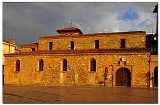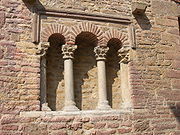
Church of San Tirso, Oviedo
Encyclopedia
The Church of Saint Thyrsus ( or ) is a Roman Catholic Asturian
Romanesque
church situated in Oviedo
, in Asturias
, northern Spain
. Dedicated to Saint Thyrsus
, it was built by Tioda
, the royal architect of Alfonso II of Asturias
. The Great Fire of Oviedo
in 1521 and rebuilding in the 18th century removed most of the original church, except for a three-light window.

.
There is no satisfactory explanation of the "many angels" the building is said to have presented in the Codex Vigilianus.
In the rectangular sanctuary atriplet round-arched window (2 by 2 m (6.6 by 6.6 ft) is preserved. With its pre-romanesque bases, rough brick arches, and capitals with rude packed leaves, it gives an idea of the better style of building and carving in the time of Alfonso II of Asturias
. It is known that the church of San Tirso housed Royal Chapel .
Asturias
The Principality of Asturias is an autonomous community of the Kingdom of Spain, coextensive with the former Kingdom of Asturias in the Middle Ages...
Romanesque
Romanesque architecture
Romanesque architecture is an architectural style of Medieval Europe characterised by semi-circular arches. There is no consensus for the beginning date of the Romanesque architecture, with proposals ranging from the 6th to the 10th century. It developed in the 12th century into the Gothic style,...
church situated in Oviedo
Oviedo
Oviedo is the capital city of the Principality of Asturias in northern Spain. It is also the name of the municipality that contains the city....
, in Asturias
Asturias
The Principality of Asturias is an autonomous community of the Kingdom of Spain, coextensive with the former Kingdom of Asturias in the Middle Ages...
, northern Spain
Spain
Spain , officially the Kingdom of Spain languages]] under the European Charter for Regional or Minority Languages. In each of these, Spain's official name is as follows:;;;;;;), is a country and member state of the European Union located in southwestern Europe on the Iberian Peninsula...
. Dedicated to Saint Thyrsus
Saint Thyrsus
Saint Thyrsus or Thyrsos is venerated as a Christian martyr. He was killed for his faith in Sozopolis , Phrygia during the persecution of Decius. Leucius and Callinicus were martyred with him. Tradition states that Thrysus endured many tortures and was sentenced to be sawn in half...
, it was built by Tioda
Tioda
Tioda was a prominent Asturian architect of the 9th century. He worked primarily in Oviedo, where he constructed the church of San Salvador which was later elevated to the rank of cathedral of the Roman Catholic Diocese of Oviedo and the Royal Palace....
, the royal architect of Alfonso II of Asturias
Alfonso II of Asturias
Alfonso II , called the Chaste, was the king of Asturias from 791 to his death, the son of Fruela I and the Basque Munia.He was born in Oviedo in 759 or 760. He was put under the guardianship of his aunt Adosinda after his father's death, but one tradition relates his being put in the monastery of...
. The Great Fire of Oviedo
Oviedo
Oviedo is the capital city of the Principality of Asturias in northern Spain. It is also the name of the municipality that contains the city....
in 1521 and rebuilding in the 18th century removed most of the original church, except for a three-light window.

Building
The building has suffered so much from alterations over the centuries and only the general plan has been preserved. It is that of a basilica with nave and aisles divided by rude stone piers set at unequal intervals, from which round arches spring. In the easternmost bay, however, owing to the smaller span, the arch was made sufficiently pointed to raise its crown to the same height as the others. This irregularity was already typical of Imperial Roman times, when barrel vaults were given a pointed form in order to make the height of rooms of varying size uniform, as it was necessary to raise the crown of the vault in some of them. This is illustrated by various chambers in the House of Tiberius on the PalatinePalatine
A palatine or palatinus is a high-level official attached to imperial or royal courts in Europe since Roman times...
.
There is no satisfactory explanation of the "many angels" the building is said to have presented in the Codex Vigilianus.
In the rectangular sanctuary atriplet round-arched window (2 by 2 m (6.6 by 6.6 ft) is preserved. With its pre-romanesque bases, rough brick arches, and capitals with rude packed leaves, it gives an idea of the better style of building and carving in the time of Alfonso II of Asturias
Alfonso II of Asturias
Alfonso II , called the Chaste, was the king of Asturias from 791 to his death, the son of Fruela I and the Basque Munia.He was born in Oviedo in 759 or 760. He was put under the guardianship of his aunt Adosinda after his father's death, but one tradition relates his being put in the monastery of...
. It is known that the church of San Tirso housed Royal Chapel .

